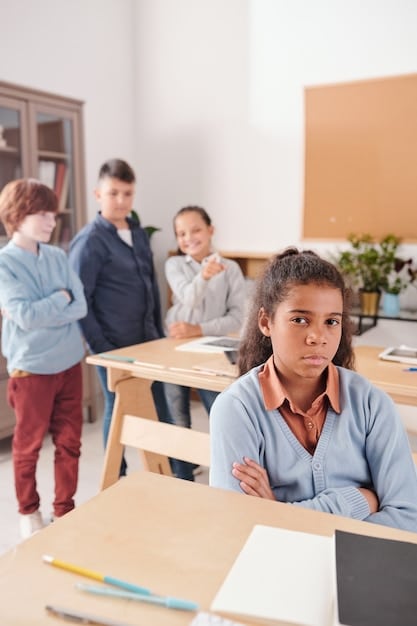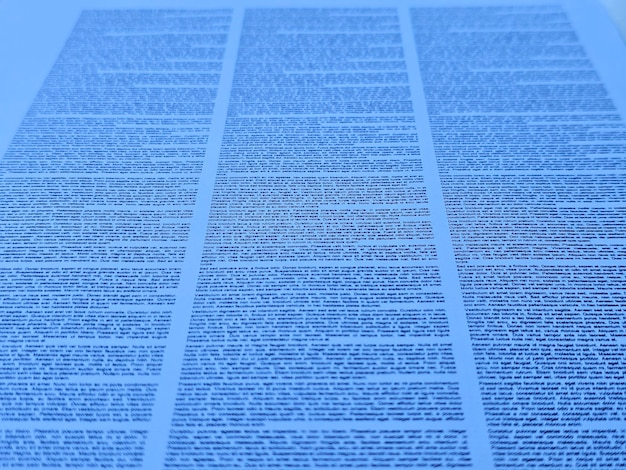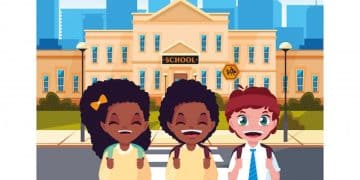The Textbook Debate: CRT, LGBTQ+ Content, and Student Understanding

The Great Textbook Debate: Are Schools Removing Critical Race Theory and LGBTQ+ Content, and What’s the Real Impact on Students’ Understanding of History? This debate revolves around concerns that certain topics are being removed or downplayed in school curricula, sparking controversy about the impact on students’ education and understanding of history and social issues.
The Great Textbook Debate: Are Schools Removing Critical Race Theory and LGBTQ+ Content, and What’s the Real Impact on Students’ Understanding of History? is raging across the United States, raising crucial questions about what students are learning and how it shapes their understanding of the world.
Understanding the Core of the Textbook Debate
At the heart of the textbook debate lies a conflict over what constitutes accurate and inclusive education. This discussion involves various stakeholders, including parents, educators, school boards, and legislators, each with distinct perspectives on curriculum content.
The central question revolves around whether certain topics, particularly those related to race, gender, and sexuality, are being adequately and appropriately addressed in textbooks and classroom discussions.
Key Areas of Contention
Several key areas are frequently cited by participants in the textbook debate. These areas often include:
- Critical Race Theory (CRT): The inclusion or exclusion of CRT, an academic framework that examines how race and racism have shaped legal systems and societal structures.
- LGBTQ+ Content: The presence or absence of LGBTQ+ topics, figures, and historical events in educational materials.
- American History: Differing interpretations of American history, particularly regarding issues such as slavery, civil rights, and social justice movements.
A common concern is the potential for bias or indoctrination in textbooks, especially when dealing with sensitive or controversial subjects. Discussions about historical events, social issues, and diverse cultures necessitate a balanced and comprehensive approach, reflecting multiple perspectives.
In conclusion, the textbook debate is a deeply complex issue rooted in varying beliefs about education and societal values. The key is to keep the students a priority.
The Role of Critical Race Theory in Education
Critical Race Theory (CRT) has become a focal point in discussions about education, sparking passionate debate and controversy. CRT is an academic framework that examines how race and racism have shaped legal systems and societal structures in the United States.
Understanding CRT is essential to comprehending its role in education. CRT posits that racism is not merely individual prejudice but is systemic and embedded in institutions, policies, and practices.

Arguments for Including CRT in Education
Proponents of CRT in education argue that it is essential for providing a comprehensive and accurate understanding of American history and society. These arguments include:
- Promoting Critical Thinking: CRT encourages students to critically examine the historical and contemporary impact of race.
- Addressing Systemic Inequities: CRT sheds light on systemic inequities that may otherwise be overlooked.
- Fostering Empathy and Understanding: CRT can promote a deeper understanding of the experiences and perspectives of marginalized groups.
Moreover, proponents argue that CRT can help students develop the critical thinking skills necessary to analyze complex social issues. By understanding how race has shaped society, students can better comprehend the challenges and opportunities facing diverse communities.
In closing, the inclusion of CRT in education is a contentious issue, with both supporters and opponents raising important questions about its potential impact on teaching and learning.
The Controversy Surrounding LGBTQ+ Content in Textbooks
Another significant aspect of the textbook debate revolves around the inclusion of LGBTQ+ content. This encompasses discussions about LGBTQ+ history, figures, issues, and experiences. The presence or absence of such content raises questions about inclusivity, representation, and the role of schools in shaping students’ understanding of identity and diversity.
The significance of LGBTQ+ content in textbooks lies in its potential to promote acceptance, reduce prejudice, and create a more inclusive learning environment for all students.
Arguments for Including LGBTQ+ Content
Those who advocate for the inclusion of LGBTQ+ content in textbooks often emphasize the following points:
- Representation Matters: Including LGBTQ+ figures and stories can help LGBTQ+ students feel seen, valued, and understood.
- Education and Awareness: LGBTQ+ content can educate all students about diverse sexual orientations and gender identities, fostering greater awareness and understanding.
- Challenging Stereotypes: Discussing LGBTQ+ issues can challenge stereotypes, reduce discrimination, and promote inclusivity.
Opponents argue that discussions about sexuality and gender identity are best left to parents or religious institutions.
In conclusion, the debate over LGBTQ+ content in textbooks reflects broader cultural and political divisions over issues of identity, sexuality, and the role of schools in addressing these topics.
The Impact on Students’ Understanding of History
The removal or downplaying of specific topics and perspectives in textbooks has a direct impact on students’ understanding of history. This can shape their perceptions of the past, influence their understanding of current events, and affect their ability to engage with complex social issues.
The curriculum and the material used to teach must reflect the nation correctly.

Potential Consequences of Content Removal
Removing or downplaying certain topics, such as CRT or LGBTQ+ history, can have several potential consequences:
- Incomplete Historical Narrative: Students may receive an incomplete or biased understanding of history.
- Limited Exposure to Diverse Perspectives: Students may not be exposed to marginalized groups and alternative viewpoints.
- Reduced Critical Thinking Skills: Reducing exposure can hinder students’ critical thinking and analytical skills.
It is essential to consider the long-term impact of these decisions on students’ education and their ability to participate in a diverse and interconnected world.
In closing, the textbook debate underscores the profound importance of a comprehensive and balanced approach to history education.
Parental Rights vs. Educational Standards
One of the most contentious aspects of the textbook debate involves the tension between parental rights and educational standards. Parents have a legitimate interest in ensuring that their children receive an education that aligns with their values and beliefs.
The conversation over what children are being taught must include parents.
Balancing Competing Interests
The challenge lies in balancing the rights of parents with the responsibility of educators to provide a comprehensive and unbiased education. Striking this balance requires:
- Transparency: Schools should be transparent about curriculum content and provide opportunities for parents to review materials.
- Dialogue: Open and respectful dialogue between parents, educators, and school boards.
- Flexibility: Schools should be flexible in accommodating diverse perspectives.
The debate has led to legislative action in some states, with laws being passed to restrict the teaching of certain topics, such as CRT or specific discussions about gender and sexuality. These laws often aim to give parents greater control over curriculum content, but they also raise concerns about censorship and academic freedom.
In summary, the tension between parental rights and educational standards is a recurring theme in the textbook debate.
Finding Common Ground and Moving Forward
Despite the deep divisions and passionate debates surrounding textbook content, it is essential to seek common ground and find ways to move forward. This requires a commitment to open dialogue, mutual respect, and a focus on the best interests of students.
The focus, always, should be what is in the best interest of the child. Not one agenda over another.
Strategies for Productive Dialogue
Productive conversations about textbook content can be facilitated by:
- Active Listening: All stakeholders should listen to understand differing perspectives.
- Fact-Based Discussions: Discussions should be based on facts and evidence.
- Compromise and Collaboration: All parties should be willing to compromise and collaborate to find solutions.
Ultimately, the goal should be to create a learning environment where students can explore diverse ideas, think critically, and develop into informed and engaged citizens.
In conclusion, the textbook debate highlights the challenges and opportunities of shaping education in a diverse and rapidly changing world.
| Key Point | Brief Description |
|---|---|
| 📚 CRT in Education | Examines the inclusion of Critical Race Theory and its impact on understanding systemic inequities. |
| 🏳️🌈 LGBTQ+ Content | Addresses the presence/absence of LGBTQ+ topics, figures, and historical events in textbooks. |
| ⚖️ Parental Rights | Discusses the balance between parental rights and educational standards in curriculum decisions. |
| 🤝 Common Ground | Emphasizes open dialogue, mutual respect, and a focus on students’ best interests for productive discussions. |
FAQ
▼
Critical Race Theory is an academic framework that examines how race and racism have shaped legal systems and societal structures in the United States. It posits that racism is systemic and not merely individual prejudice.
▼
Including LGBTQ+ content can promote acceptance, reduce prejudice, and create a more inclusive learning environment for all students. It helps LGBTQ+ students feel seen, valued, and understood.
▼
Parental rights in education refer to the rights of parents to ensure that their children receive an education that aligns with their values and beliefs. This includes the right to review curriculum materials.
▼
Schools can balance parental rights with educational standards through transparency about curriculum content, open dialogue between parents and educators, and flexibility in accommodating diverse perspectives.
▼
Removing or downplaying certain topics can result in an incomplete historical narrative, limited exposure to diverse perspectives, and reduced critical thinking skills among students, impacting their overall education.
Conclusion
The ongoing textbook debate serves as a crucial dialogue about the values, perspectives, and historical narratives we impart to our students. By fostering open discussions, respecting diverse viewpoints, and prioritizing comprehensive education, we can strive to equip future generations with the knowledge and critical thinking skills necessary to navigate an increasingly complex world.





